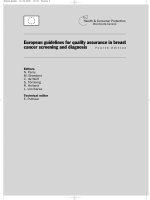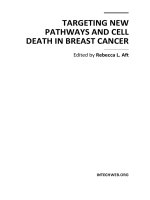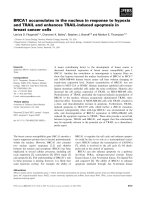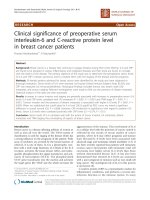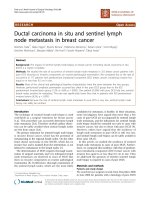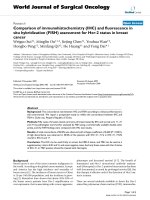EZH2 and NF KB crosstalk in breast cancer
Bạn đang xem bản rút gọn của tài liệu. Xem và tải ngay bản đầy đủ của tài liệu tại đây (2.55 MB, 146 trang )
EZH2 AND NF-κB CROSSTALK IN BREAST CANCER
LEE SHUET THENG
NATIONAL UNIVERSITY OF SINGAPORE
2012
EZH2 AND NF-κB CROSSTALK IN BREAST CANCER
LEE SHUET THENG
B.SC. (HONS) in Biological Sciences
Nanyang Technological University, SINGAPORE
A THESIS SUBMITTED
FOR THE DEGREE OF DOCTOR OF PHILOSOPHY
NUS GRADUATE SCHOOL FOR INTEGRATIVE SCIENCES
AND ENGINEERING
NATIONAL UNIVERSITY OF SINGAPORE
2012
Declaration
I hereby declare that the thesis is my original work and it has been written by me in its
entirety. I have duly acknowledged all the sources of information which have been
used in the thesis.
This thesis has also not been submitted for any degree in any university previously.
_______________________
Lee Shuet Theng
i
Acknowledgment
First of all, I would like to express my heartfelt gratitude to my Ph.D supervisor, Prof.
Yu Qiang, for his guidance and encouragement throughout the course of my Ph.D studies.
Under his guidance, I have gained scientific knowledge and was trained in multiple aspects of
scientific research from constructing a project flow, interpreting data to writing a manuscript.
I would also like to take this opportunity to express my appreciation to another supervisor,
A/Prof. Liou Yih Cherng, for being so encouraging and supportive throughout these four
years of Ph.D course.
I am extremely grateful to NUS Graduate School for Integrative Sciences and
Engineering (NGS) for sponsoring my Ph.D studies as well as the annual overseas
conferences. I would also like to express my thanks to Genome Institute of Singapore (GIS),
which has provided me a great and conducive environment to pursue my project.
It is a pleasure to work with my colleagues in GIS. Acknowledgment to Chew Hooi,
Cheryl, Yuanyuan, Zhimei, Puay Leng, Tanjing, Zhenlong, Fengmin, Jiangxia, Mei Yee,
Adrian, and Shun Sheng for their constructive suggestions that help to move my project along.
I would also like to convey my thanks to all my colleagues for being wonderful friends and
made my graduate experience more enjoyable.
Finally, I would like express my deepest love and gratitude to my mother, sisters, and
all my family members. Thanks for providing me with mental supports, tolerating my
nonsense, sharing my joys as well as hardships with me throughout this difficult but enriching
Ph.D course.
ii
Table of Contents
Acknowledgment i
Table of Contents ii
Summary v
List of Tables vii
List of Figures viii
List of Abbreviations x
CHAPTER 1: INTRODUCTION 1
1.1 Breast Cancer 2
1.1.1 Basal-like breast cancer (BLBC) 5
1.1.1.1 Aggressive phenotypes of BLBC 5
1.1.1.2 Pathways driving BLBC oncogenicity 8
1.1.1.3 Current therapy of BLBC 11
1.1.2 Luminal breast cancer 14
1.1.2.1 Phenotypes 14
1.1.2.2 Pathways driving luminal breast cancer oncogenicity 15
1.1.2.3 Current therapy 16
1.2 EZH2 18
1.2.1 EZH2 and PRC2 complex 19
1.2.2 Modes of transcriptional repression 21
1.2.2.1 Histone ubiquitination 21
1.2.2.2 DNA methylation 21
1.2.2.3 Histone deacetylation 22
1.2.2.4 Chromosome remodeling 22
1.2.3 EZH2 and cancers 23
1.2.3.1 Transcriptional repression of tumor suppressor genes 24
1.2.3.2 Histone methylation-independent functions 25
1.2.4 Regulation of EZH2 in cancers 26
1.2.4.1 Regulation of EZH2 expression 26
1.2.4.2 Regulation of EZH2 activity 27
1.2.4.3 Steering of PRC2 binding to targets 28
1.2.5 EZH2 and breast cancer 30
1.3 NF-κB 31
1.3.1 NF-κB as a family of transcription factors 31
1.3.1.1 Canonical NF-κB pathway 32
iii
1.3.1.2 Non-canonical NF-κB pathway 33
1.3.2 NF-κB and cancers 35
1.3.2.1 Oncogenic functions of NF-κB 35
1.3.2.2 Constitutive activation of NF-κB in cancers 36
1.3.2.3 Targeting NF-κB in cancers 37
1.3.3 NF-κB in breast cancer 39
1.4 Aims and Objectives of Study 41
CHAPTER 2: MATERIALS AND METHODS 42
2.1 Cell culture and treatments 43
2.2 Cryopreservation of cell lines 43
2.3 Transfection of Small interfering RNA 44
2.4 Transfections of transient overexpression plasmids 44
2.5 Generation of stable overexpression cell lines 45
2.6 RNA extraction 45
2.7 cDNA conversion and Quantitative real-time PCR (RT-PCR) 46
2.8 Microarray Gene Expression Profiling and Analyses 46
2.9 Gene Ontology analysis 47
2.10 Protein extraction 47
2.11 Western Blotting 48
2.12 Co-immunoprecipitation (co-IP) 48
2.13 Chromatin Immunoprecipitation (ChIP) and Sequential ChIP 49
2.14 Recombinant Protein Expression 50
2.15 In vitro pull down and re-IP 51
2.16 Transwell Invasion Assay 51
2.17 3D Matrigel Anchorage-Independent Growth Assay 52
2.18 Dual Luciferase Reporter Assay 52
2.19 Clinical Datasets and Survival Analysis 53
2.20 Statistical Analysis 53
CHAPTER 3: EZH2 AND NF-ΚB CROSSTALK IN BASAL-LIKE BREAST CANCER
54
3.1 EZH2 Positively Regulates NF-κB-Mediated Gene Network in Aggressive BLBC Cells
55
3.2 EZH2 Positively Modulates NF-κB Target Gene Expression Independently of Histone
Methyltransferase Activity. 61
3.3 EZH2 Forms a Ternary Complex with RelA and RelB in Aggressive Breast Cancer
Cells 65
3.4 EZH2 and RelA/RelB Co-Regulate a Subset of NF-κB Targets by Inter-Dependent
Promoter Occupancy 72
3.5 NF-κB Target Gene Signature Co-Regulated by EZH2, RelA, and RelB Discriminates
Basal vs Luminal Subtype of Breast Cancers and is Associated with Poor Disease Outcome
81
iv
CHAPTER 4: EZH2 AND NF-ΚB CROSSTALK IN LUMINAL BREAST CANCER . 90
4.1 EZH2 Negatively Regulates NF-κB Target Genes in ER Positive Luminal Breast
Cancer Cells 91
4.2 EZH2 interacts with ER and co-occupy NF-κB target genes promoter together with the
enrichment of H3K27me3 mark 93
4.3 Ectopic RelB expression alters EZH2 regulation of NF-κB targets 96
CHAPTER 5: CONCLUSIONS AND PROPOSED MODEL 97
CHAPTER 6: DISCUSSION 99
6.1 New mode of NF-κB Constitutive activation in Aggressive Breast Cancers 100
6.2 RelA and RelB Conundrums 102
6.3 Antagonism between EZH2/ER and NF-κB pathway 104
6.4 Context-specific mode of NF-κB pathway regulation by EZH2 and its Clinical
Implications 105
6.5 EZH2 acts more than a methyltransferase in oncogenic progression 106
6.6 Significance of Study 109
6.7 Future Prospects 111
APPENDICES 112
REFERENCES 115
List of Publications 132
v
Summary
Basal-like breast cancer (BLBC) and luminal breast cancer are two major subtypes of
breast cancer and BLBC represent the more aggressive subtype compared to luminal breast
cancer. This observation is associated with higher expression of EZH2 and constitutive
activation of NF-κB pathway in BLBC. In this study, we sought to dissect the crosstalk
between EZH2 and NF-κB under these two cellular contexts.
From our genome-wide mRNA expression profiling in a BLBC cell line, MDA-MB-
231, EZH2 was found to positively modulate NF-κB-mediated inflammatory responses. This
relationship was validated by a series of cell-based assays. We examined the DNA
recruitment of EZH2 and NF-κB on the promoter of NF-κB target genes as well as the
changes of the target genes expression. EZH2 was found to exert a positive role in regulating
DNA binding activity of RelA and RelB, and accordingly upregulate the expression levels of
NF-κB target genes. Using co-immunoprecipitation and in vitro pull down assay, we
demonstrated that EZH2 could physically interact with RelA and RelB forming a ternary
complex. These interactions did not require SET domain of EZH2, suggesting a novel
function of EZH2 independent of its SET-dependent histone methylation activity.
The importance of this crosstalk was further demonstrated by analyzing
EZH2/RelA/RelB coregulated genes in terms of their association with metastases in different
breast cancer subtypes. Strikingly, there was a set of 12 genes, which were consistently
expressed higher in BLBC or ER-negative breast cancer tissues and showed significant
association with lung and brain metastases. This outcome revealed a potential role of
EZH2/RelA/RelB crosstalk in promoting invasion and metastasis of aggressive breast cancer.
Unlike ER-negative BLBC cells, ER-positive luminal breast cancer cells showed
reduced level of RelB and concurrently exhibit high level of ER as well as its cofactors such
as FOXA1 and GATA3. Under this cellular context, EZH2 was found to function as a
negative regulator of NF-κB target genes expression. This regulation was revealed to be
vi
dependent on the canonical H3K27 trimethylation activity of EZH2, potentially recruited by
ER to the promoter of NF-κB target genes IL8 and IL6. Interestingly, the ectopic
overexpression of RelB in ER-positive luminal breast cancer cell line, MCF7, could partially
revert the function of EZH2 to become the transactivator of NF-κB target gene, IL6. These
observations suggest that the presence of RelB and ER as possible crucial determinants of the
functionality of EZH2 in regulating NF-κB gene network.
Taken together, this study proposed a model highlighting a dual-function of EZH2 in
modulating NF-κB network depending on cellular context. Importantly, the balance of ER
and RelB expression could possibly be the major factors in determining the mode of EZH2
regulation on NF-κB network.
vii
List of Tables
Table 1.1: Intrinsic subtypes of breast cancer.
Table 1.2: Six subtypes of triple negative breast cancer based on gene expression profiling.
viii
List of Figures
Figure 1.1 Structure of breast and subtype classification.
Figure 1.2 Hazard rates for distant recurrence of TNBC and non-TNBC breast cancer.
Figure 1.3 Epithelial to mesenchymal transition in cancer progression.
Figure 1.4 Trends of death rates in female breast cancer patients in United States.
Figure 1.5 Protein Structure of EZH2.
Figure 1.6 PRC2 complex formed by polycomb protein components.
Figure 1.7 Overexpression of EZH2 in multiple cancer types.
Figure 1.8 EZH2 mediates silencing of multiple genes involved in various oncogenic
functions.
Figure 1.9 Protein structures of NF-κB subunits.
Figure 1.10 Canonical and non-canonical pathways of NF-κB.
Figure 3.1 Ingenuity pathway analyses of genesets regulated by EZH2 in MB231.
Figure 3.2 Inflammatory network and its related genes regulated by EZH2.
Figure 3.3 Overlap of EZH2-, RelA-, and RelB-regulated genesets.
Figure 3.4 EZH2 depletion reduced NF-κB reporter activity.
Figure 3.5 EZH2 WT and SETΔ rescued NF-κB reporter activity.
Figure 3.6 Stable overexpression of EZH2 WT and SETΔ induced NF-κB activity.
Figure 3.7 EZH2 physically interacted with RelA and RelB endogeneously.
Figure 3.8 EZH2 WT and SETΔ physically interacted with RelA and RelB.
Figure 3.9 EZH2, RelA, and RelB direct interacted with each other to form a ternary complex.
Figure 3.10 RelB depletion disrupted EZH2-RelA interaction.
Figure 3.11 Two clusters of EZH2/NF-κB regulated genes.
Figure 3.12 Ectopic expression of RelA and RelB induced the expression of different subsets
of genes.
Figure 3.13 A Model proposed two modes of transcription regulation by EZH2 and NF-κB.
Figure 3.14 Promoter occupancy of EZH2, RelA, and RelB in MB231.
Figure 3.15 Knockdown-ChIP of EZH2, RelA, and RelB in MB231.
Figure 3.16 Sequential ChIP of EZH2, RelA, and RelB in MB231.
ix
Figure 3.17 Hierarchical clustering of breast cancer cell lines based on expression of
EZH2/NF-κB coregulated genes.
Figure 3.18 Expression of 12 signature genes and ER associated genes.
Figure 3.19 Expression of RelA, RelB, EZH2 and other two PRC2 components.
Figure 3.20 Kaplan-Meier analyses based on expression of 12 signature genes.
Figure 3.21 Kaplan-Meier analyses based on expression of EZH2/RelB independent RelA
regulated genes
Figure 3.22 EZH2, RelA, and RelB depletion reduced invasiveness and aggressiveness of
MB231.
Figure 4.1 Inversely correlated expressions of NF-κB targets and ER-related genes in MB231
and MCF7.
Figure 4.2 ER and EZH2 depletion enhanced IL6 and IL8 expressions.
Figure 4.3 ER interacted with EZH2 and SuZ12 and dissociated in response to TNFα.
Figure 4.4 ER, EZH2, and H3K27me3 enrichment on IL6 and IL8 promoter reduced upon
TNFα stimulation.
Figure 4.5 Ectopic RelB expression in MCF7 reversed EZH2 regulation of IL6 expression.
Figure 5.1 A proposed model of context-dependent EZH2 modulation of NF-κB pathway in
breast cancer.
Figure 6.1 Two proposed models of constitutive activation of NF-κB in breast cancer.
x
List of Abbreviations
3D
Three dimensional
AR
Androgen receptor
BIRC3
Baculoviral IAP repeat containing 3
BLBC
Basal-like breast cancer
BMI1
B lymphoma Mo-MLV insertion region 1
BRCA1/2
Breast cancer 1/2, early onset
CBX1
Chromobox homologues
CCNB1
Cyclin B1
CDK1/2
Cyblin-dependent kinase 1/2
ChIP
Chromatin immunoprecipitation
CK5/6/7/8/17/18/19
Cytokeratin 5/6/7/8/17/18/19
co-IP
Co-immunoprecipitation
COX1/2
Cyclooxygenase 1/2
CSC
Cancer stem cell
CTC
Circulating tumor cells
DAB2IP
DAB2 interacting protein
DMSO
Dimethyl sulfoxide
DNMT
DNA methyltransferase
DTT
Dithiothreitol
DZNep
3-Deazaneplanocin A
EDTA
Ethylenediamine tetra-acetic acid
EED
Embryonic ectoderm development
EGF
Epidermal growth factor
EGFR
Epidermal growth factor receptor
EMSA
Electrophoretic mobility shift assay
EMT
Epithelial to mesenchymal transition
ER
Estrogen receptor
EZH2
Enhancer of zeste homologue 2
FBS
Fetal bovine serum
FDA
Food and Drug Administration
FGF
Fibroblast growth factor
FOXA1
Forkhead box A1
GATA3
GATA binding protein 3
GFP
Green fluorescence protein
GST
Glutathione S-transferase
H3K27
Histone 3 Lysine 27
H3K27me3
Histone 3 Lysine 27 trimethylation
HAT
Histone acetyl transferase
HDAC
Histone deacetylase
HER2
Human epidermal growth factor receptor 2
HMEC
Human mammary epithelial cell
IKK
IκB kinase
IL1
Interleukin 1
xi
IL6
Interleukin 6
IL8
Interleukin 8
IPA
Ingenuity pathway analysis
IκBα
NF-κB inhibitor α
JMJD3
Jumonji D3
LTβ
Lymphotoxin β
MBP
Maltose-binding protein
MDB
Methyl-CpG binding domain proteins
miRNA
Micro RNA
mRNA
Messenger RNA
NF-κB
Nuclear factor of kappa light polypeptide gene enhancer in B-cells
NLS
Nuclear localization signal
PAGE
Polyacrylamide gel electrophoresis
PARP
Poly(ADP-ribose)polymerase
PBS
Phosphate-buffered saline
PcG
Polycomb group
pCR
Pathological complete response
PMSF
Phenylmethylsulfonyl fluoride
PR
Progesterone receptor
PRC1
Polycomb repressor complex 1
PRC2
Polycomb repressor complex 2
PRE
Polycomb response element
PTGS2
Prostaglandin-endoperoxide synthase 2
PVDF
Polyvinyllidene difluoride
RTK
Receptor tyrosine kinase
RT-PCR
Real-time polymerase chain reaction
SAA1
Serum amyloid A1
SDS
Sodium dodecyl sulphate
siRNA
small-interfering RNA
SUZ12
Suppressor of zeste 12
TNBC
Triple-negative breast cancer
TNF
Tumor necrosis factor
TSS
Transcription start site
UTR
Untranslated region
WT
Wild type
Xist
X inactivation specific transcript
1
CHAPTER 1: INTRODUCTION
2
1.1 Breast Cancer
Breast cancer is the most common cancer in women and it is the second leading cause
of cancer death in women after lung cancer. Breast is constituted of ducts, lobules, adipose,
connective and lymphatic tissues. Breast cancer is normally arised from ductal or lobular
tissues (Figure 1.1A). At the initial stage of tumor development, the tumor mass is confined in
the ductal or lobular structure, it is termed in situ carcinoma. In situ carcinoma usually would
result in a good clinical outcome as long as it is surgically removed. On the other hand, when
the cells become invasive and infiltrate to the adjacent tissue, there would be a high
possibility that it will metastasize to other organs and often results in poor prognosis
(AmericanCancerSociety, 2011).
Breast cancer could also be classified into basal-like and luminal subtypes based on
molecular expression profiling (Perou et al., 2000). These two subtypes are generally viewed
as different disease entities and have very different intrinsic gene expression patterns. Mainly,
there are two cell types that exist in the ductal and lobular tissues, namely luminal and
myoepithelial (Figure 1.1B). Both basal and luminal breast cancer cells are proposed to be
originated from the luminal lineages but arised at different stages of development. Basal-like
breast cancer was believed to develop from the luminal progenitor cells that are more
pluripotent and mesenchymal as compared to the luminal breast cancer that was proposed to
develop from more differentiated luminal stage (Prat and Perou, 2009). Thus, basal-like breast
cancer retains the expression of genes that are present in the myoepithelial lineage that was
branched right before or at the stage of luminal progenitor. On the other hand, luminal breast
cancer which develops later has lost the traits of myoepithelial cells and instead gained the
expression of the genes that is similar to the differentiated luminal cells.
3
The heterogeneity of breast cancer was intensively being studied by the advancement
of gene expression profiling using high throughput technologies. Basal-like and luminal
breast cancer are now further subcategorized into several subgroups based on the expression
of specific genes (Lehmann et al., 2011). In addition, more breast cancer subtypes that are not
categorized to luminal and basal-like also emerged, for instance claudin-low breast cancer
(Table 1.1 and Table 1.2) (Peddi et al., 2012). In this thesis, my focus will be on the basal-like
and luminal breast cancer in general.
Figure 1.1 Structure of breast and subtype classification
A. Anatomy structure of breast organ. (Adapted from: gical-
blog.com/breast-cancer-about-breast-cancer-breast-cancer-risk-and-
symptoms/)
B. Luminal and basal-
like breast cancer classification was defined by the
expression profiles of the intrinsic genesets.
(Adapted from:
A
B
4
Intrinsic subtypes of breast
cancer
Characteristics
Luminal A
High level expression of ER and ER-associated genes,
associated with a favorable clinical outcome.
Luminal B
Low level expression of ER and ER-associated genes,
associated with a higher tumor cell proliferation rate and a
worse clinical outcome compared to the luminal A
subtype.
HER-2 Enriched
High level expression of HER2 and GRB7, associated with
a poor outcome before the era of HER2-targeted agents.
Basal-like
Positive for the expression of basal cytokeratin but
negative for the expression of luminal- and HER2-related
genes, asso
ciated with a high tumor cell proliferation rate
and a poor clinical outcome.
Normal-like
Similar expression compared to normal breast, suspicious
for normal cell contamination.
Claudin-low
Lack the expression of claudin proteins that are implicated
in cell-
cell adhesion, but high expression of EMT and
putative stem cell markers, associated with ER and HER2
negativity but low in basal cytokeratin expression.
Table 1.1: Intrinsic subtypes of breast cancer(Peddi et al., 2012)
Subtype
Gene expression profile
Basal-like 1 (BL-1)
High in the expression of genes involved in cell cycle
progression, cell division, and DNA damage response
pathways.
Basal-like 2 (BL-2)
High in the expression of genes involved in cell cycle
progression, cell division, and growth factor signaling.
Immunomodulatory (IM)
High in the expression of genes involved in immune
processes and cell signaling.
Mesenchymal (M)
High in the expression of genes involved in motility and
extracellularmatrix.
Mesenchymal stem-like (MSL)
High in the expression of genes involved in motility,
extracellular matrix, and growth factor signaling;
consistent with claudin-low Intrinsic subtype.
Luminal androgen receptor
(LAR)
High in the expression of genes involved in hormonally
regulated pathways.
Table 1.2: Six subtypes of triple negative breast cancer based on gene expression
profiling. (Peddi et al., 2012)
5
1.1.1 Basal-like breast cancer (BLBC)
About 15% of breast cancer is categorized as basal-like breast cancer (BLBC) (Rakha
et al., 2008). BLBC could be distinguished from luminal breast cancer by
immunohistochemistry staining of the markers that are expressed specifically in basal-like
cells, for instance keratin 5, keratin 6, and keratin 17. Another common characteristic of
basal-like breast cancer cells is the lack of expression of several surface receptors like
estrogen receptor (ER), human epidermal growth factor receptor 2 (HER2), and in most of the
cases progesterone receptor (PR). Due to the negativity of the expression of these receptors,
this subtype of breast cancer is also known as triple-negative breast cancer (TNBC) (Foulkes
et al., 2010). About 70-80% of BLBC cells are TNBC and more than 80% of TNBC belongs
to BLBC. Furthermore, there are great similarities shared between TNBC and BLBC in terms
of clinical prognosis and therapeutic responses (Badve et al., 2011). In fact, many clinical
trials that were supposedly performed in BLBC were carried out in patients stratified by
triple-negativity status due to convenient and pragmatic purposes (Rakha et al., 2008;
Santana-Davila and Perez, 2010). Therefore, although it was reported that the overlap
between these two breast cancer types is not complete, many papers still used BLBC and
TNBC interchangeably. Concordantly, in the introduction, I will summarize the findings in
BLBC and TNBC in a collective manner.
1.1.1.1 Aggressive phenotypes of BLBC
BLBC frequently occurs in young women especially from black and Hispanic races
compared to other ethnic groups (AmericanCancerSociety, 2011). Patients with BLBC tend to
have adverse prognosis and early relapse within five years after treatment (Fig 1.2) (Rakha et
al., 2008). The recurrent tumors are always found to be at the distal organs from breast,
indicating the occurrence of metastatic events. Metastasis is an event when tumor cells
6
disseminate from its primary niche to other sites of the body to form secondary tumors
(Nguyen et al., 2009). It happens when tumor progresses to higher grade and attain invasive
and aggressive properties. Metastasis is the main cause that renders this disease to be
incurable.
Clinical observation has revealed that different types of cancer could have preference
towards the sites where they metastasize to, this phenomenon termed “organ tropisms” (Chu
and Allan, 2012; Nguyen et al., 2009). For instance, breast cancer preferentially metastasizes
to lymph nodes, lungs, brain, liver, and bone; whereas prostate and colorectal cancers tend to
spread to bone and liver, respectively. Interestingly, it was reported that different subtypes of
breast cancer could too have different preference towards sites of metastasis: BLBC has
higher propensity to spread to brain, lung, and liver whereas luminal breast cancer has higher
propensity to spread to bone, liver, and lung (Foulkes et al., 2010).
Two factors were proposed to influence the aggressiveness of BLBC, the
mesenchymal phenotype and the enriched population of cancer stem cells. Under normal
circumstances, epithelial cells are well-organized and reside within the basement membrane
Figure 1.2 Hazard rates for distant recurrence of TNBC and non-TNBC breast
cancer. (Foulkes et al., 2010)
7
with regular apical basolateral polarity. During cancer progression, the cancer cells would
undergo a process called epithelial-mesenchymal transition (EMT) (Kang and Massague,
2004; Thiery, 2002), in which the cells would gradually lose the expression of cell-cell
junction molecules (e.g., E-Cadherin) , which results in the disorganization of the cell polarity
and the gain of cell motility (Figure 1.3). The cells would then invade out from the primary
tumor site, migrate and colonize distal organs to form secondary metastases. It was
discovered that EMT features happen more frequently in BLBC (Sarrio et al., 2008) Many of
the BLBC cell lines are locked in mesenchymal state with characteristics which are highly
motile, invasive, lack of cell-cell adhesion junction and often appear to have spindle-shaped
morphology.
Another factor that contributes to the aggressiveness of BLBC is the high proportion
of cancer stem cells (CSC) in BLBC (Honeth et al., 2008). CSC represents a population of
cells that is able to initiate tumor formation and subsequent tumor maintenance in vivo. As
CSC is found to be resistant to chemotherapy, it has been regarded to be the main culprit of
Figure 1.3 Epithelial to mesenchymal transition in cancer progression (Thiery, 2002).
8
tumor relapse. The first isolation of CSC in breast tumors was achieved by Al-Hajj et al. via
fluorescence-activated cell sorting based on the expression of the surface markers
CD44
+
/CD24
-/low
.(Al-Hajj et al., 2003) The isolated cells were demonstrated to be able to
generate tumor in vivo with as few as 100 cells injected. Strikingly, BLBC has been reported
to be enriched in CD44
+
/CD24
-/low
cell population (Honeth et al., 2008; Park et al., 2010).
This could serve as the cause of clinical observation that BLBC tends to have early relapse
after chemotherapy due to the presence of high fraction of CSC.
CSC was shown to have increased metastatic propensity in vitro and in vivo, albeit
mechanism remains unclear (Chu and Allan, 2012). Intriguingly, it was suggested that EMT
could accelerate the formation of CSC (Floor et al., 2011; Morel et al., 2008). A recent paper
even proposed that EMT cells and CSC are overlapped and among the EMT cells
disseminated from the tumor only the most competent CSC will eventually succeed to
metastasize (Floor et al., 2011). Although the relationship between EMT and CSC is complex
and perplexing, their association with cancer metastasis is evident. As BLBC is enriched in
both CSC and EMT phenotypes, propensity to metastasize is also unquestionable.
1.1.1.2 Pathways driving BLBC oncogenicity
Cancer development and progression often involves the activation of oncogenic
pathways and inactivation of tumor suppression pathways by genetic or epigenetic changes.
Different cancer types may have dependency on the dysregulation of different signaling
pathways. In BLBC, several pathways are known to be dysregulated and contributed to its
progression, for instance silencing of ER and BRCA1, overexpression or activation of EGFR,
VEGFR, SRC, PI3K, and NF-κB pathways.
As mentioned earlier, more than 80% of BLBC is TNBC, lacking the expression of
ER, PR and HER2. In fact, many studies have demonstrated that the absence of ER is one
major factor of the aggressiveness of BLBC (Fearon, 2003; Rochefort et al., 1998).
Exogeneous expression of ER in BLBC was shown to reduce the invasiveness and
9
aggressiveness of the cells . The mechanism behind ER-mediated suppression of cancer
invasiveness is not largely understood, although several findings have demonstrated that ER
negatively regulates the expression of the components in NF-κB pathways, including RelB,
IL6, and IL8 (Freund et al., 2003; Freund et al., 2004; Stein and Yang, 1995; Wang et al.,
2007). NF-κB pathway was long known to be constitutively activated in BLBC, and it is
shown to be associated with the aggressiveness of this subtype of breast cancer (Gionet et al.,
2009; Huber et al., 2004; Karin and Greten, 2005). However, the mechanism underlying the
constitutive activation of NF-κB pathway is not well understood.
EGFR is frequently overexpressed in BLBC (Dent et al., 2007). In some studies,
EGFR is even proposed to be one of the molecular markers of BLBC apart from the
negativity of ER, PR, HER2 and the expression of basal keratins (Shao et al., 2011;
Siziopikou and Cobleigh, 2007). Recent reports indicated that the overexpression EGFR
protein level is largely due to gene amplification in BLBC (Gumuskaya et al., 2010; Shao et
al., 2011). As a consequence of EGFR overexpression, EGFR signaling was found to be
overactivated in BLBC. Besides promoting the survivability of cancer cells, the activation of
EGFR pathway in BLBC was shown to enhance the mesenchymal phenotypes of this cancer
subtype (Ueno and Zhang, 2011).
Tumor cells are fast growing cells but the growth of tumor mass is restricted by the
availability of nutrients and oxygen. Thus, when the tumor mass grows to a certain size,
typically 1-2mm (McDougall et al., 2002), tumor cells would secrete growth factors like
fibroblast growth factor (FGF) and vascular endothelial growth factor (VEGF) that will
induce a process called angiogenesis. Angiogenesis is one crucial process during tumor
progression, involving the development of blood vessels at the site where tumor mass grows.
The blood capillaries that grow into the tumor mass would nourish the tumor cells to support
further tumor growth. Besides nutrients and oxygen supply, angiogenesis was indicated to
promote metastasis. Cancer cells that gain metastatic potential could invade into the blood
vessels and enter the blood circulation and turn out to be circulating tumor cells (CTC). CTC
10
was demonstrated to correlate with the development of secondary metastatic tumors
(Cristofanilli et al., 2004).
SRC is a non-receptor tyrosine kinase, which would relay phosphorylation signaling
upon activation by growth factor receptor. As consequences of dysregulated SRC activation,
the cells would gain oncogenic responses such as increase in cell proliferation, survivability,
angiogenicity, and motility (Gelman, 2011; Wheeler et al., 2009). It was reported that SRC is
overactivated in BLBC, and BLBC cells were found to be more susceptible for SRC
inhibitors (Finn et al., 2011; Tryfonopoulos et al., 2011), implicating the dependency of
BLBC on the dysregulated SRC activity.
Besides the abovementioned factors/pathways that contribute to the aggressiveness of
BLBC, there are also pathways that are known to be governing the survivability or
proliferation specifically in BLBC subtype. BRCA1 is a tumor suppressor, which functions to
repair double-stranded breaks in DNA for instance during the events of homologous
recombination. BRCA1 expression could be silenced by genetic (inactivating mutation) or
epigenetic (promoter hypermethylation and microRNA regulation) mechanisms (Rakha et al.,
2008; Rice et al., 1998; Shen et al., 2009; Shen et al., 2010). Loss of the expression of
BRCA1 leads to error-prone DNA repair, thereby increasing the risk of genetic mutations and
hence predisposed to cancer development. It was discovered that breast cancer that arises
from BRCA1-deficient cells shares great similarity to BLBC in terms of clinical
characteristics and intrinsic gene expression (Santana-Davila and Perez, 2010). Although it is
unclear of the cause and effect relationship between BRCA1-associated breast cancer and
BLBC, some reports have suggested that BLBC is more tolerable to the deficiency of BRCA1
(Bryan et al., 2006; Dabbs et al., 2006) while some other reports have suggested that loss of
BRCA1 leads to the development of cancer with more stem-cell like properties (Foulkes,
2004; Furuta et al., 2005), which is in concordance with the phenotype of BLBC.
11
When BLBC cells were defined based on the triple-negativity status, researchers
discovered that there is a subgroup of BLBC segregated with luminal breast cancer based on
expression profiling despite of the absence of ER, PR, and HER2 (Doane et al., 2006).
Subsequently, it was demonstrated that the expression of androgen receptor (AR) causes the
similarity of this BLBC subgroup with luminal breast cancer, therefore this subtype of breast
cancer is named as luminal androgen receptor (LAR). Investigators reported that the
expression of AR in LAR renders the proliferative advantage of this cancer subtype.
In addition to the aforementioned pathways that are more specifically being
activated/inactivated in BLBC/TNBC compared to other cancer subtypes, many other
oncogenic pathways are also revealed to play essential roles in promoting breast cancer in
general, including both BLBC and luminal breast cancer (Cleator et al., 2007; Santana-Davila
and Perez, 2010). For example, PI3K/AKT/mTOR and Ras/MEK/MAPK pathways were
known to promote survivability and proliferation in breast cancer. Ordinarily, the pathways
that are dysregulated are not mutually exclusive, multiple oncogenic pathways could be
turned on and multiple tumor suppressor pathways could be turned off simultaneously and
contributed to oncogenesis.
1.1.1.3 Current therapy of BLBC
Most BLBC lacks the expression of ER, PR, and HER2, rendering this cancer
subtype irresponsive to receptor targeted therapy. Hence, chemotherapy is the mainstay
therapeutic option for the treatment of this subtype of breast cancer (Berrada et al., 2010).
Chemotherapeutic drugs are also known to be cytotoxic drugs that attempt to kill fast growing
cells. In the case of neoplasia, chemodrugs are effective in the treatment by exploiting the fact
that the tumor cells proliferates much faster than normal cells. There are several types of
chemotherapeutic agents which are frequently used in neoadjuvant or adjuvant therapy of
BLBC (Cleator et al., 2007; Santana-Davila and Perez, 2010), including (i) anthracyclines -
